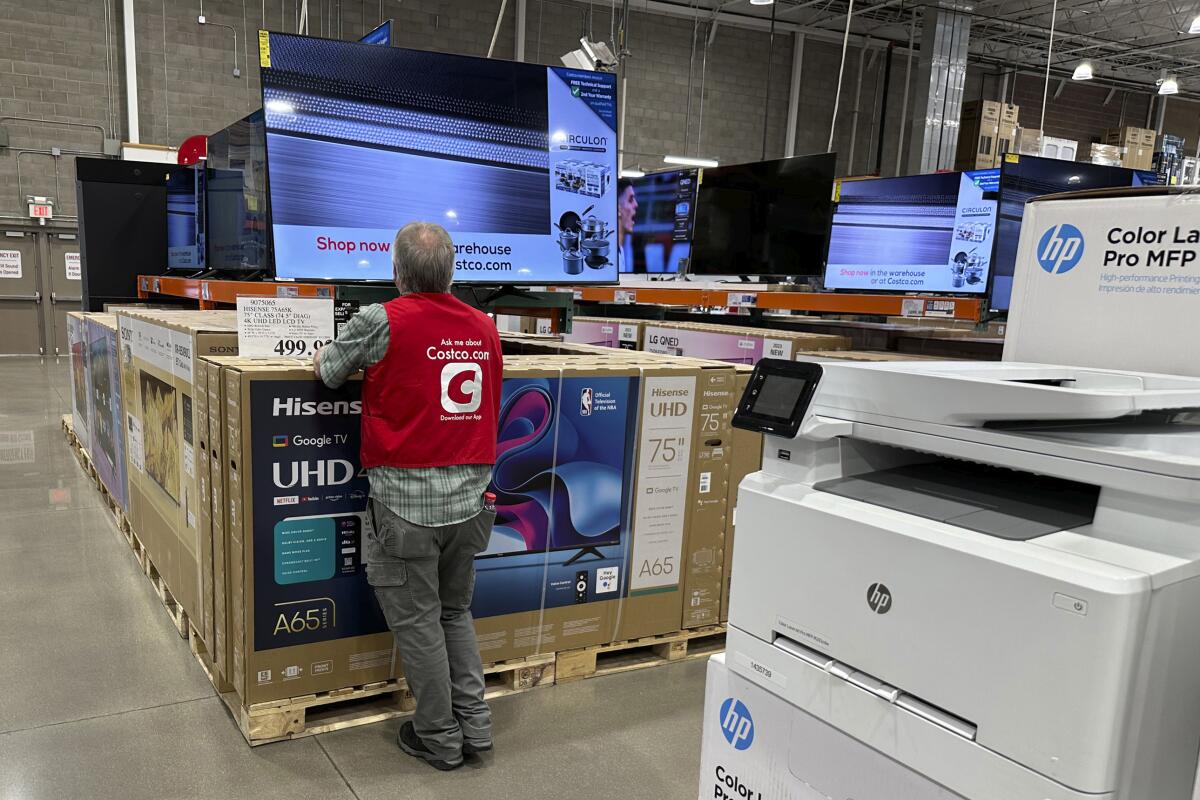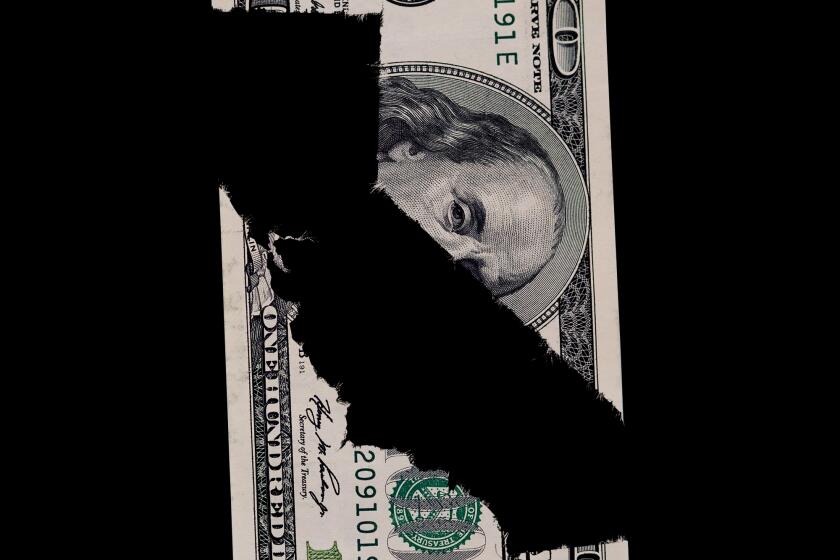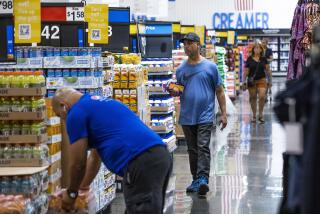Inflation slows but remains elevated, a sign price pressures are easing only gradually

Consumer inflation in the United States cooled last month yet remained elevated, the latest sign that the pandemic-fueled price surge is only gradually and fitfully coming under control.
Tuesday’s report from the Labor Department showed that the consumer price index rose 0.3% from December to January, up from a 0.2% increase the previous month. Compared with a year ago, prices are up 3.1%.
That is less than the 3.4% figure in December and far below the 9.1% inflation peak in mid-2022. But the latest reading is still well above the Federal Reserve’s 2% target level at a time when public frustration with inflation has become a pivotal issue in President Biden’s bid for reelection.
Excluding volatile food and energy costs, so-called core prices climbed 0.4% last month, up from 0.3% in December. On a year-over-year basis, core prices were up 3.9% in January, the same as in December. Core inflation is watched especially closely because it typically provides a better read of where inflation is likely headed.
Tuesday’s report showed that the drivers of inflation have decisively shifted from goods, like used cars, gasoline and groceries, which are now falling in price or rising much more slowly, to services, including hotel rooms, restaurant meals and medical care. That shift could raise concerns for the Fed, because services inflation typically takes longer to recede.
An uptick in nationwide inflation could have bigger consequences for Californians who are already paying higher prices for basic goods and services, including housing and energy.
At his most recent news conference, Fed Chair Jerome H. Powell singled out persistently high services prices as a concern and indicated the central bank’s policymakers would like to see services inflation ease further before starting to cut their key interest rate.
“There’s still some inflation in the system that’s going to take some time to work through,” said Omair Sharif, founder of Inflation Insights, a research firm. “This justifies the Fed wanting to wait and see how things are going to go.”
Tuesday’s unexpectedly sticky inflation data sent stock and bond prices tumbling, with financial markets now envisioning the Fed’s first rate cut in June, rather than in May or March as many traders had previously expected.
The Standard & Poor’s 500 fell 1.4% on Tuesday after clawing back part of a larger intraday loss. The Dow fell 1.4% and the Nasdaq composite tumbled 1.8%. Treasury yields surged in the bond market.
Biden administration officials responded to Tuesday’s report by noting that average hourly pay, adjusted for inflation, rose in January and is 1.4% higher than it was a year earlier. But the average workweek has declined because some businesses have reduced their employees’ hours, leaving weekly inflation-adjusted pay slightly lower than it was a year earlier.
“We understand there’s more work to be done, but this is an economy that is in a much different place than it was a year ago,” said Karine Jean-Pierre, the White House press secretary. “When you see eggs and milk and products like that at the grocery store going down, they’re lower than they were a year ago, that’s important.”
Some economists cautioned against assigning too much weight to January’s inflation data, noting that many companies impose annual price increases in the first month of the year, imparting a temporary boost to January’s figures. The government seeks to seasonally adjust the data to account for such trends but doesn’t always do so perfectly.
In a reversal from past decades, more college graduates and professionals are moving out of California than coming into it to escape the higher taxes and cost of living.
A raft of forward-looking data, in fact, suggests that inflation will continue to cool. The pace of wage growth has slowed, which reduces the pressure on companies to raise prices to offset higher labor costs. And consumers and business owners collectively expect lower inflation in the coming months and years, surveys show, a sentiment that can itself hold down price increases.
From December to January, average gas prices nationwide tumbled 3.3%, the government said. Yet so far this month, the average price has climbed higher, rising 15 cents to $3.23 a gallon as of Tuesday, according to AAA.
Grocery prices rose 0.4% from December to January, the biggest such rise in a year, though compared with 12 months earlier, food prices are up just 1.2%.
But the costs of services — including auto insurance, apartment rents and concert tickets — are still rising faster than they did before the pandemic and keeping overall inflation persistently high. The cost of car insurance has soared more than 20%, on average, compared with a year ago.
Such price bumps are causing heartburn for many consumers. Bill Milligan of Atlanta said he was stunned last month to find that the cost of insuring one of his cars had soared nearly 30% compared to six months earlier.
“I was going, ‘What the hell is that?’” Milligan said of discovering the charge on his bank statement.
Milligan, a 46-year-old software architect, called his insurance company, which confirmed that the price increase didn’t reflect any recent tickets or accidents and said he was still receiving a discount for insuring several cars at once, or his premium would have been higher.
“And they’re like, ‘Yeah, sorry, it’s just the price of everything is going up,’” Milligan said.
Milligan, who said he received a substantial pay raise last year, acknowledged that financially he is still doing fine.
“I can’t complain about this,” he said, referring to inflation overall.
But as with many Americans, higher prices have caused him to worry about the future. He wonders how his oldest of three daughters, who wants to become a teacher, will live on an educator’s salary with costs having risen so high.
The mixed data released Tuesday will probably reinforce the caution of Fed officials, who have said they’re pleased with the progress in sharply reducing inflation but want to see further evidence before feeling confident that it’s sustainably headed back to their 2% target. Most economists still think the Fed will start cutting its rate in June from its 22-year high of roughly 5.4%.
Another driver of high prices has been housing costs, particularly the price of homeownership. It rose 0.6% from December to January, the biggest one-month jump since April. That measure is 6.2% higher than it was a year earlier.
But housing costs should moderate in the coming months. The price of new apartment leases has been declining steadily as new apartment buildings have been completed. It can take months for the drop in new lease prices to filter through into the government’s data.
At the same time, economists say that inflation in healthcare services is likely to stay high. The cost of hospital services jumped 1.6% just from December to January. Doctors’ services rose 0.6%.
Sharif said those increases likely reflected, in part, sharp pay gains in recent years for nurses and other in-demand medical workers, such as anesthesiologists and radiologists.
The Fed raised its key rate 11 times from March 2022 to July of last year in a concerted drive to defeat high inflation. The result has been much higher borrowing rates for businesses and consumers, including for mortgages and auto loans. Rate cuts, whenever they happen, would eventually lead to lower borrowing costs for many categories of loans.
Lower borrowing costs could boost economic growth. But a strong economy may also pose a challenge for the Fed because faster growth can accelerate wages and consumer spending. If businesses aren’t able to keep up with greater customer demand, they typically respond by raising prices, which would worsen inflation.
AP writer Josh Boak contributed to this report.
More to Read
Inside the business of entertainment
The Wide Shot brings you news, analysis and insights on everything from streaming wars to production — and what it all means for the future.
You may occasionally receive promotional content from the Los Angeles Times.












